An Exceptional Paradise
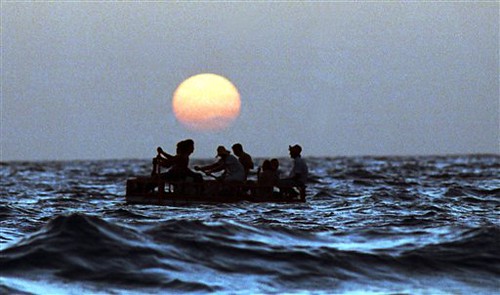
[Image: Balsero Rafter Crisis (1994)]
OK, I dug up some scoop on the migrant detention facility that’s being developed on the “Leeward North” side of the Guantanamo Bay Naval Base directly adjacent to the “Windward” side where the terrorist suspects are being held at Camp Delta. I somehow missed a few news articles about this in the Camp Justice post a few days back – so, here’s an update.
As it turns out the proposal to build warehousing structures for interdicted refugees in the event of a ‘hypothetical Caribbean boat crisis’ is already well under way. Even though Defense Secretary Robert Gates shot down a costly proposal for a $125m Military Commissions Courthouse earlier this year, the Miami Herald, who has been doing a good job of keeping watch on Guantanamo’s base development, says progress is being made on the migrant detention installation with some lucrative contracts in the works.
It appears the Bush administration has not only been preparing for what’s being referred to as a “theoretical humanitarian relief mission” by developing a sheltering scheme capable of accommodating 10,000 people – for those either “fleeing a political crisis” or “a natural disaster” – but there is another second wave proposal (no pun intended) that is looking to build out even larger facilities for an additional 35,000 potential migrants.
That’s the architectural equivalent of a small California suburb; a suspended city of netted refugees perched right there on the lush exotic tip of Guantanamo Bay – in a state of exceptional paradise, Agambenian bliss – where 330 terrorist suspects are already camped alongside the ballooning new temporary courthouse complex I mentioned earlier, none of which differ that much structurally at all, really.
At a cost of $16.5m the Navy, according to the Miami Herald has “hired a Jacksonville contractor to build concrete buildings with 525 toilets and 248 showers on an empty corner of the Guantánamo Bay, Cuba, base.” This equates to roughly a couple dozen concrete block latrine buildings that Reuters says will be able to withstand 130 mile per hour hurricanes, each capable of providing emergency shelter for up to 500 people. The plan would be to station extra tents around these buildings if more shelter space becomes needed. This particular installation is expected to be ready by the summer of 2008.
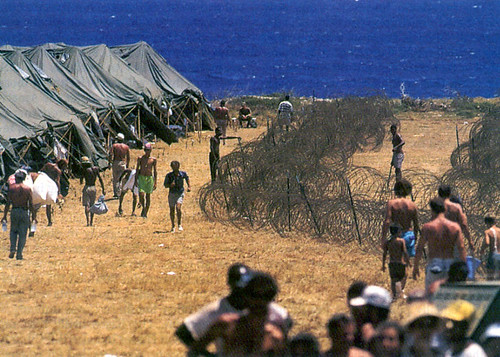

[Images: Balsero Rafter Crisis (1994)]
But, you must remember the 46,000 Haitian and Cuban refugees that were temporarily captured at this very same location during the ‘94-‘95 mass exodus to the U.S.? For months families remained in tents on an abandoned airfield and some old beat-up golf course. It was estimated that over the course of a year or so more than 60,000 refugees were forced to squat in those tents on the base until most of them were eventually deported back to their countries. A news brief from CNN back in January of 1996 reported while most of those tents were broken down the Pentagon stated “facilities for 10,000 migrants will be kept in case they are needed in the future.”
Since then other propositions have been floated around to locate refugees from other parts of the word there, like the Kosovars in 1999.

The Rueters piece also tells us the new building progress is part of ‘Operation Vigilant Sentry,’ “the government's multi-agency plan to thwart a mass influx of boat people fleeing political upheaval or natural disaster in the Caribbean.” By the year-end concluded back in September the Coast Guard supposedly intercepted 2,868 migrants in the Florida Straits, “slightly above totals for the previous two years.”
Rueters also writes, “Work was finished a couple of years ago on a site that could hold up to 400 migrants in tents and cots stored in shipping containers on the base. A barbed-wire fence separates it from a neighboring galley and bar.” According to The Herald this compound already “shelters up to about 40 asylum seekers on the base at a time.” In theory, the article explains, should there become a demand the military personnel running Camp Delta would deploy these tents to shelter increases in nabbed migrants.
So, the numbers of Florida-bound boaters rises and the Pentagon kicks preparations into high gear, for migrants, maybe, sure – or maybe for something else, we don’t really know for sure, do we? Regardless, Guantanamo is definitely getting some serious upgrades and we can only be cautious about how far they will go.
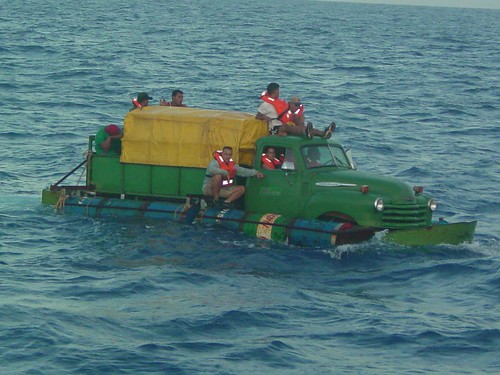
[Image: Rafters from Cuba en route to Florida, USA, via Floating Cubans.]
Both articles mention recent government bids were being sought for another $40m project to expand the infrastructure so that it could accommodate 35,000 more people pushing the overall detention capacity to 45,000, back to ’95 crisis numbers. Though, they also state that no bids have yet been put out for this next phase, and other estimates actually project a much higher cost for such an expansion that is realistically closer to $110m, which is where DS Gates’ comments come back into play. What will actually constitute the next phase of the base’s urban development remains to be seen.
But, there you have it – Guantanamo Bay is undergoing the kind of construction that would make any budding bay resort proud, even if it’s for interdicted refugees. Of course, I’m being somewhat sarcastic here. It’s hardly becoming a bay resort, but in its own bizarre and exceptional sort of way, maybe it is – just not for migrants, but rather politicos and contractors who are cultivating the perfect extraterratorial island retreat to conduct the shady military maneuverings that have defined Guantanamo’s legal status in the first place.
Even though some of these projects (Camp Delta, Camp Justice, Camp America, Leeward North, etc.) are said to be separate from one another (functionally and literally), the fact they share the base itself and come from the same site begs the question: how coordinated will their functionality in the end actually become? Am I crazy to express concern over asylum seekers one day being processed through the same legal machinations as the enemy combatant detainees? In other words, could Leeward North become a way to suspend refugee and migrant rights and militarize the legal process for asylum seekers? Or, maybe the opposite could be true. With the disturbing interlacing of political narratives between the issues of immigration and national security that has occurred post 9/11 it comes as no surprise to see these separate spaces emerging in similar forms – the tent city – coming together, mutually confirming each other’s structural (and ultimately political) usefulness in some way.

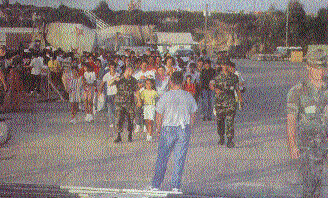
Forgive my skepticism, but perhaps the legal practice of Leeward North is merely a way to help legitimize the dubious legal nature of the base’s operations – as an attempt to validate Guantanamo Bay’s indefinite detention of Al Q suspects in some capacity.
Though, is it really even possible to separate these camps from one another? Aren’t they all just pop-ups on the same landscape? Since both immigration and national security are ultimately trumped by the agenda of terrorist prevention one can’t just sit back and read about these ‘separate sites’ without considering their abysmally blurry spatial connections.
If we were to put the amount of new construction at Guantanamo Bay into a different perspective, say, seeing the amount of development in relation to its own size and scale, for example – then we might say the Cuban base (which is only 45 square miles) is seeing more building per sq. mile than that of China, the most booming place on the planet currently. Now, I realize that’s an absurd comparison (especially since I don’t know the exact square mileage of total construction at GB or China), but it goes to show how much attention (and the kind of attention) Guantanamo is getting these days. I wonder where New Orleans would fit into this silly little scale? I mean, how many refugees do we still have there waiting for housing, for infrastructure, and what is the American government doing? Building multi-million dollar vacant emergency housing containers for a theoretical mass exodus on the sub-legal shores of one of the most controversial military sites in our times.
America’s priorities never cease to amaze.
More interesting to consider though may be what the base might look like fifty or a hundred years from now? It wouldn’t be foolish to assume that in that time the War on Terror roundups will continue to swell by the thousands, as will, sadly to say, probably ICE's illegal immigration raids; or, that Caribbean nations like Haiti and Cuba will slip further into economic desperation. More than likely the region will be repeatedly ravaged by phenomenal hurricanes and wayward cyclones, while biblical flooding will drown the landscape to the point of new generations needing to rear their young on a lifetime of stranded rooftops. NAFTA and its intercontinental highway I bet will produce a goliath backlash of illegal immigration, while migration from Mexico and the entire southern continent will find dramatic new sites of contest as border militarization intensifies. I guess, all of which makes the refugee interdiction compound make sense, from the Pentagon’s point of view.
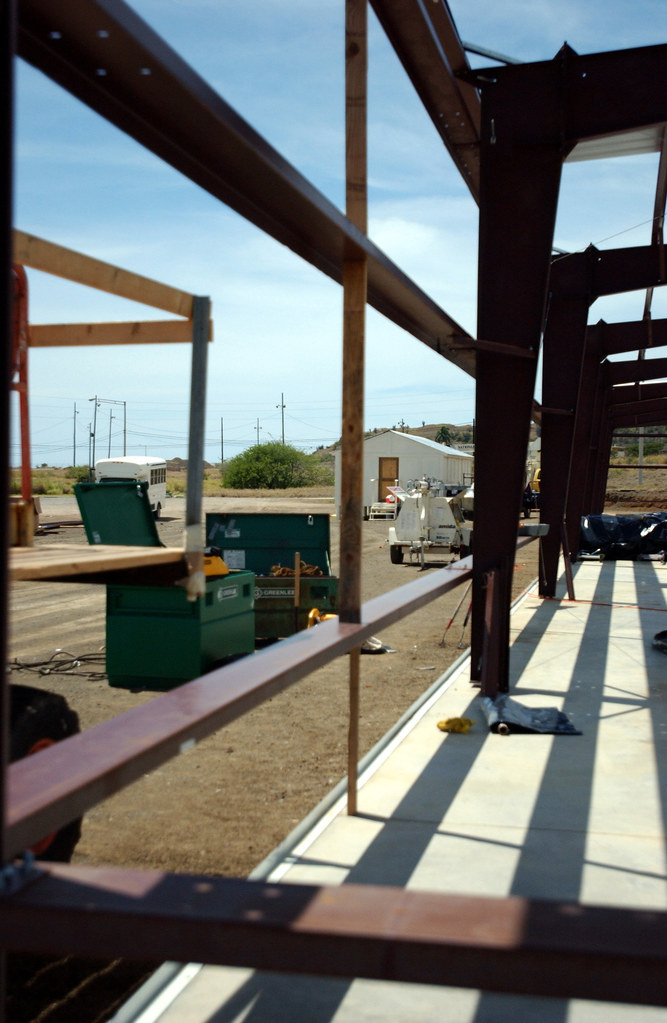
[Image: Photo by Army Sgt. Sarah Stannard, Guantanamo migrant operations facility will assist refugees in distress, Oct. 3, 2007.]
And so, who will be living there over this time? Unlawful enemy combatants, Haitian children, Cuban fathers, Muslim extremists, Hispanic agriculturalists, Army sergeants and their golfing buddies? If we think about this from the perspective of prison operators, then in order to build detention facilities you have to make sure to fill them afterwards. So, as Gitmo’s new structures become more permanent I wonder how long it will take for the Pentagon to fill them. Will they one day be brimming with an ambiguous overflow of brown faces blended by the desperate looks of weary migrants and the hopeless portraits of lifelong terrorist suspects? Or will Guantanamo Bay become more permanently temporary like a pop-up landscape secretly perforated with tent cities that can just as easily be assembled as they can be put away – will Leeward North be the ultimate hurricane proof migration detention facility of the future? What about that damned golf course, I wonder how it looks these days. Maybe it can be expanded from a dippy little nine-hole to a full eighteen in years to come and Camp X-Ray can host a PGA tournament there to benefit the rights advocacy for the Accused Military Prison Torturers and Abusers Coalition (AMPTAC).


Sorry, I’m being ridiculous I know, but let’s just say for a moment that the hypothetical boat crisis never comes, what will the vacant refugee Holiday Inn latrines be used for then? It seems unlikely they’ll just sit there indefinitely unused in the absence of any exodus. Or have they already taken into account how Leeward’s tent city might serve other strategies for the rest of the base in the meantime?
Tell me I won’t one day see an entire population of quarantined detainees there making up a kind of global capital city for trying the War on Terror’s suspected losers?
One thing for sure, it looks like the U.S. is mimicking the offshore bufferzone strategy Australia uses with its detention islands situated around Indonesia, and Europe who keeps African refugees at bay by stashing them in foreign military bases on the northern coast of Algeria and Libya.
In the end, hundred of years from now, will the whole thing be a Global Warming-proof well-oiled extralegal machine-city designed specifically for the purposes of trying the migrating suspects of global terrorism?







2 Comments:
...Or maybe it's just preparations for the invasion of Cuba.
I've been searching for pictures of guantanamo bay at that time. My boyfriend was there then,and he enjoyed these pictures. We are looking for news footage of a hunger strike from guantanamo bay in 1995, or atleast pictures. HELP?
Post a Comment
<< Home